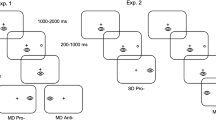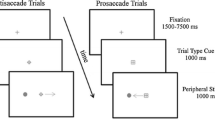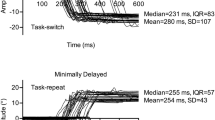Abstract
Smaller latency costs for switching from dominant (habitual) to non-dominant (unusual) tasks compared to the reverse direction have been noted in some studies of task-switching. This asymmetry has been cited as evidence of inhibitory effects from the prior trial. We examined accuracy and latency costs of task-switching between prosaccades and antisaccades, where taskswitching is limited to stimulus-response re-mapping and occurs between tasks highly asymmetric in dominance. Eighteen subjects executed prosaccades and antisaccades in single-task and mixed-task blocks. In mixed-task blocks, antisaccade and prosaccade trials were ordered randomly, resulting in ‘repeated’ trials that were preceded by the same type of trial (i.e. antisaccade-antisaccade), and ‘switched’ trials that were preceded by the opposite type of trial. Comparisons of the single-task blocks and repeated trials of the mixed-task blocks indexed the mixed-list costs, which were small for prosaccades and insignificant for antisaccades. Comparison of the repeated and switched trials from the mixed-task blocks indexed the residual task-switch cost. Accuracy costs of task-switching and antisaccades were equivalent. The accuracy of trials incorporating both switching and antisaccades in a single response (i.e. switched antisaccade) equalled the product of the accuracies of doing each operation alone, supporting independence of these two functions. In contrast, the latency cost of antisaccade performance was 3 times greater than that of taskswitching. Task-switching from prosaccades to antisaccades resulted in a paradoxical decrease in antisaccade latency. This decrease correlated with other indices of vigilance, with the paradoxical effect minimized in more attentive observers. The latency data suggest that either an antisaccade on the prior trial perturbs saccadic responses more than a task-switch, or concurrent taskswitching specifically facilitates antisaccades. In either case, the paradoxical benefit of task-switching for antisaccades challenges current models of task-switching.
Similar content being viewed by others
Author information
Authors and Affiliations
Corresponding author
Rights and permissions
About this article
Cite this article
Cherkasova, M.V., Manoach, D.S., Intriligator, J.M. et al. Antisaccades and task-switching: interactions in controlled processing. Exp Brain Res 144, 528–537 (2002). https://doi.org/10.1007/s00221-002-1075-z
Received:
Accepted:
Published:
Issue Date:
DOI: https://doi.org/10.1007/s00221-002-1075-z




